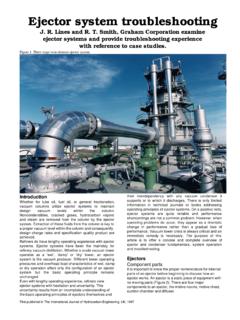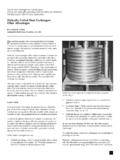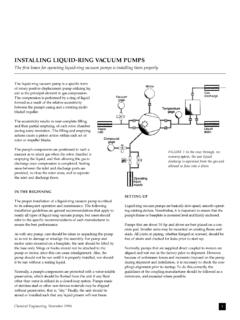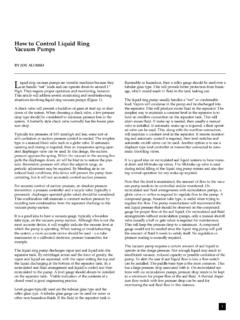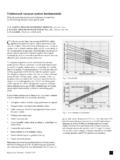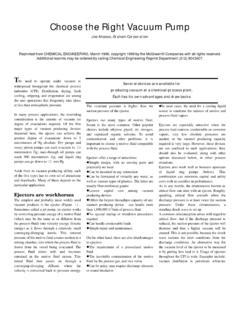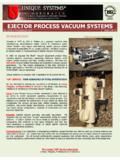Transcription of Ejectors - Graham
1 Air Ejectors Cheaper Than SteamWhen all the cost factors are considered, theair-operated ejector often proves to be the superior method for producing vacuum. Here are figures you can Duncan BerkeleyFor many years the air-operated ejectorhas been a neglected child in the field ofvacuum producing apparatus. It hasbeen greatly overshadowed by its highlysuccessful, fully reliable and popular kin,the steam ejector . The popularity of thesteam ejector has been somewhatjustified because air-operated ejectorshave been limited in their use by arelatively expensive and somewhatscarce supply of high-pressure motiveair. Major reasons for selecting steamrather than air to operate Ejectors havebeen the unavailability of aircompressors and the relatively high costof compressed air in most in air compressors havegreatly reduced the cost of compressedair as compared to 20 years ago; andthe greater availability of compressed airin process plants today makes the airejector a reasonable and in someinstances a preferred means ofproducing a fact that air is a non-condensiblegas under common conditions oftemperature and pressure, limits its useas a propelling material for Ejectors totwo or three stages.
2 In a steam ejectorthe steam from each stage of multistageunits can usually be condensed in anintercondenser and the successivestage need handle only the non-condensible gases plus a relativelysmall saturation component from allprevious stages. By condensing themotive steam from previous stages, it isboth economical and practical to use asmany as five or more ALL THE FACTORSR ecent tests and studies on air-operated Ejectors have brought to lightsome rather interesting and useful factsconcerning these units. The results,although neither highly revolutionary norstartling, prove that the air jet has thesame desirable feature as the steam jet;and in some instances can prove to bevery economical and more desirablethan the steam factors of cost should be carefullyconsidered for a specific are: Initial cost of the equipment used toproduce the compressed air or steam .
3 Versatility of employing steam or airgenerating equipment for other uses in aplant or process. Relative costs of compressed air andsteam for a particular locality. Operating requirements for the ejector ,both vacuum and load. With all of thesefactors in mind, using the air-operatedejector often proves to be quite superiorto other methods of producing THEY WORKAll Ejectors operate on a commonprinciple. They entrain air or other fluidsin a high velocity jet of propelling air, steam , water or other fluid. And theyuse the kinetic energy in the highvelocity stream of that fluid to push backthe atmosphere from the discharge ofthe would suggest that the higher thevelocity of the jet from the nozzle of theejector, the greater the pressure againstwhich the ejector can exhaust.
4 Or if theexhaust pressure remains constant, thehigher the vacuum produced by theejector. This is true and for anyparticular velocity of the jet there is, ofcourse, a limit to the vacuum that canbe I illustrates approximately theconversion of air pressure into velocity inthe nozzle of the ejector and theconversion of velocity into pressure inthe , under the same conditions oftemperature and pressure, has lessinternal energy in its molecules thansteam. And theoretically air cannotproduce as high a vacuum as cansteam. However, the inefficiencies of theexpansion and compression processesin an ejector when the ejector isoperating over its maximum range ofcompression obscure the differences inultimate vacuum most practical purposes a one ortwo stage air ejector will produce ashigh an ultimate vacuum as will a one ortwo stage steam ejector .
5 The steam jet,however, requires fewer lbs. of motivefluid to evacuate a closed vessel thanthe air jet and fewer of motive fluidto exhaust a constant load at aparticular vacuum as compared to an airjet. Therefore we need to know someadditional comparative characteristics tobase our cost estimates OF COMPARISONB ecause 100 psig. is a very commonpressure for both compressed air andsteam in industrial plants, it is a goodpressure on which to base a comparisonbetween air-operated and steamoperated F. is approximately the maximumair temperature at which 100 psig. singlestage air compressors will deliver airwithout requiring the compressor to runexcessively hot.
6 The hotter the air to theejector, the less air is required by theejector for any particular condition ofvacuum and the air aftercooler of a compressor isbypassed or if the cooling water to theaftercooler is shut off, relatively hot aircan be obtained for use in an by doing so the air storage tankcapacity is reduced and condensate willcollect in the storage tank and air might be undesirable for somecompressed air installations. It is moredesirable to heat the air by means of anelectric heater or with a steam to airheat exchanger. Only a very smallamount of electricity or low pressuresteam is required to reach 200 1 - ejector nozzle converts air pressure into velocity and the diffuser convertsvelocity back into pressure.
7 (or hotter), and in most cases thereduced air requirements of the ejectorare well worth the additional heating motive air to 200 F., the airrequired to operate an ejector can bereduced to as little as 70% of the airrequirements for 70 F. air. Sometimesair Ejectors are selected to keep thetemperature of the load fluid low. Thisrules out steam Ejectors . And to removethe load fluid in condensers mostefficiently it would then be necessary tooperate the ejector with cold RESULTSData from our test runs on one and twostage air Ejectors (of optimum design)correlate very well with data on steamejectors. We used air at 100 psig. and200 F.
8 In our tests and compared theresults with steam Ejectors operating on100 psig. dry saturated steam .Single stage air Ejectors require lb. of air to handle the samecondition of vacuum and load that steam will when it is supplied to asingle stage steam a two stage air ejector , lb. ofair will be needed to do the same jobthat lb. of steam will do in a twostage non-condensing steam ratios change somewhat whenthe pressure of the motive air ischanged. A typical figure for singlestage might be lb. of 200 psig air perlb. of dry saturated steam at 200 lb. of 60 psig. air per lb. of drysaturated steam at 60 psig.
9 Fig. 2 shows the ratio of motive air toload air required for one stage absolute pressure scale covers theoperating vacuum range of one stageunits. Fig. 3 shows the ratio of motive airto load air required for typical two stageejectors designed for any particularvacuum in the operating range for twostage Ejectors . The ratios are based onsupplying motive air at 100 psig. and200 F. to remove load air at 70 ratios will be higher for load airabove 70 F. and lower for load air below70 F. But the corrections are smallbetween 50-90 F. If the ejector is tohandle a fluid other than air, the flowratio must be corrected for the differencein the thermodynamic properties of theload fluid and those of air.
10 Thiscorrection factor is usually considered afunction of the relative molecular weightsof the load fluid and 2 shows that for pressure above Hg abs., a single stage air-operatedejector is more economical to operatethan a two stage ejector (when themotive air pressure is 100 psig.). Theexact pressure at which two stages ofcompression become more economicaldepends on the pressure of the motiveair supply. Absolute pressures as lowas in. Hg abs. (10 mm.) arepractical with a two stage IT COSTSFigs. 4, 5 and 6 show the operatingcosts of one and two stage air ejectorswhen the cost of the compressed air manufacturers haveorganized and published much usefuldata which permit an analysis ofcompressed air costs.
